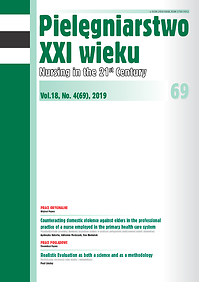Selected aspects of patients’ functioning before and after desensitization with specific allergen immunotherapy
DOI:
https://doi.org/10.2478/pielxxiw-2019-0033Keywords:
allergy, quality of life, specific allergen immunotherapyAbstract
SELECTED ASPECTS OF PATIENTS’ FUNCTIONING BEFORE AND AFTER DESENSITIZATION WITH SPECIFIC ALLERGEN IMMUNOTHERAPY
Introduction. Allergic diseases belong to the most important health problems responsible for the incidence of various types of discomfort. The application of specific allergen therapy (SAI) is becoming a more and more frequent method aimed at treating allergic diseases. However, this approach requires a strict adherence to medical treatment, which may affect patients’ quality of life.
Aim. Assessment of quality of life and everyday functioning in the group of patients who underwent a specific allergen therapy.
Material and methods. The study group consisted of 80 adult patients who decided to undergo SAI treatment and were treated in two health care facilities in Małopolska region. The study included an assessment of life quality and selected aspects of functioning (as well as their retrospective assessment). As far as the applied methods are concerned, the study was based on the authors’ own questionnaire and an abbreviated version of the World Organization Quality of Life-BREF questionnaire.
Results. SAI treatment made it possible to reduce both the incidence (Me=4.00 to 2.00; p<0.001) and intensity (Me=4.00 to 2.00; p<0.001) of allergic symptoms. Also the discomfort caused by the allergy was decreased (Me=4.00 to 2.00; p<0.001). Moreover, some improvement in general well-being (Me=4.00 to 5.00; p<0.001) and life satisfaction (Me=4.00 to 5.00; p<0.001) was observed.
Conclusions. Specific allergen immunotherapy seems to be worth considering as it improves patients’ life satisfaction and reduces discomfort caused by the allergy itself.
References
1. Samoliński B, Raciborski F, Lipiec A i wsp. Epidemiologia chorób alergicznych w Polsce (ECAP). Alergologia Polska-Polish Journal of Allergology. 2014;1(1): 10-18.
2. The European Academy of Allergy and Clinical Immunology 2015. Pobrane z: https:// www.eaaci.org/documents/EAACI_Advocacy_Manifesto.pdf (dostęp: 1.09.2019)
3. Gawlik R, Zagórny G, Bożek A. Farmakoekonomiczne aspekty zastosowania immunoterapii alergenowej w leczeniu alergicznego nieżytu nosa i astmy. Alergologia Polska-Polish Journal of Allergology. 2017;4 (2): 63-67.
4. Stanisławska M, Iwanowska K, Jurczak A i wsp. Jakość życia pacjentów z alergicznym nieżytem nosa. Family Medicine & Primary Care Review. 2015;17 (3): 205-209.
5. Ścibor M, Balcerzak B, Czarnecka Ż, Malinowska-Cieślik M. Ocena jakości życia pacjentów z astmą oskrzelową mieszkających w Krakowie w strefach różniących się stężeniem pyłu zawieszonego w powietrzu (PM10). Medycyna Środowiskowa- Environmental Medicine. 2015;1 (18): 45-53.
6. The World Health Organization. The World Health Organization Quality of Life (WHOQOL) – BREF 2004. (dostęp: 1.09.2019)
7. Golicki D, Styczen P, Szczepkowski M. Quality of life in stoma patients in Poland: multicentre cross-sectional study using WHOQOL-BREF questionnaire. Przegląd Epidemiologiczny. 2013;67 (3): 491-496.
8. Gniadek A, Malinowska-Lipień I, Solarz P, Marcisz E. Jakość życia chorych z astmą oskrzelową leczonych immunoterapią swoistą. Pielęgniarstwo XXI wieku. 2015;51 (2): 5-10.
Published
Issue
Section
License
Copyright (c) 2019 Authors

This work is licensed under a Creative Commons Attribution-NonCommercial-NoDerivatives 3.0 Unported License.




